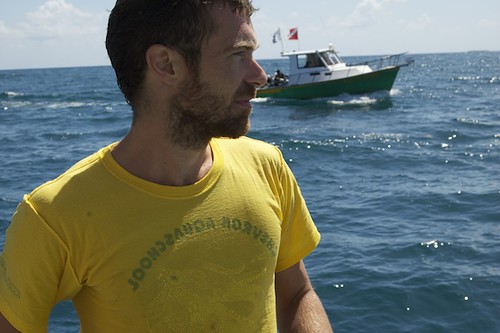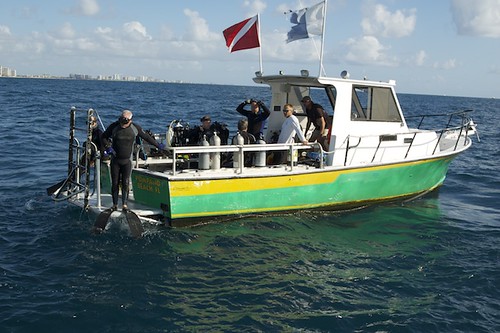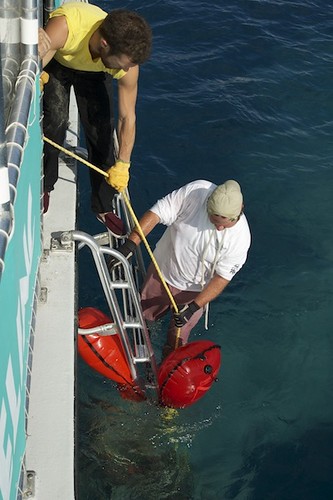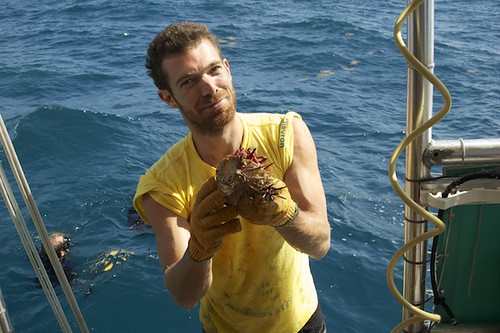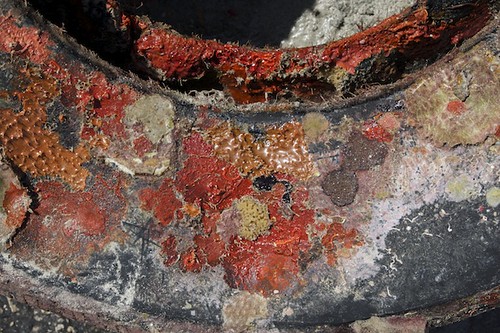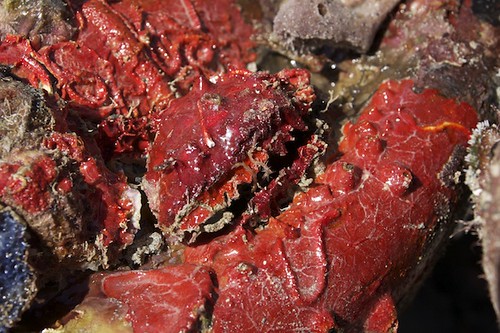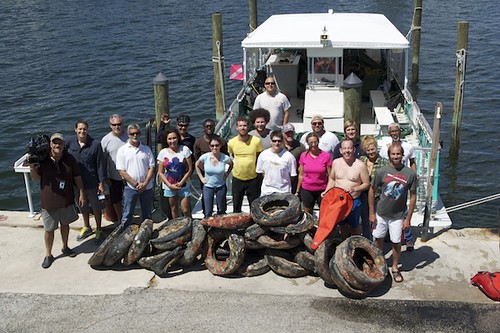(Note* – We had to migrate the site to new servers and were down a few days. Please, excuse and accept our disappearance, and thank you for your patience. Ed.)
Artists are constantly full of crazy ideas, aren’t they? How about this nearly impossible effort to raise tires off the bottom of the Atlantic Ocean from a failed artificial reef. Many Fort Lauderdale residents still vividly remember the Osborne Reef, constructed of concrete jacks in a 50 ft. (15 m) diameter circle. Well, the project ultimately failed, and the “reef” has come to be considered an environmental disaster—ultimately doing more harm than good in the coastal Florida waters.
Berlin-based artist Hannes Bend, presented his exhibition, “Eclipse,” at Charest-Weinberg Gallery, open to the public on Friday, March 30th and will be on view through June 2nd, 2012.
Let’s go back a bit because this exhibition is the result of an arduous expedition and retrieval that cannot be ignored.
We all awoke before the sun came up on that fateful Friday, ready to head out to sea. After all the gear and provisions were loaded, we headed out into the crisp morning breeze from Hillsborough Inlet. The seas were about 4 foot, but we managed to walk around and prep the deck while the second boat circled around looking for the best location to send the divers over the stern.
Starting slowly the tires were retrieved and came up heavy with water and sand, and encrusted with sparse growth. We spent eight hours out on the water. Some living creatures were found and returned to the depths: brittle star, octopus, crowie, sea slug, and sea urchin were the most significant ones. In between the tire recovery we had lulls with lots of conversation about the initial depositing of tires for this failed reef, various issues up and down the coast, regulations and enforcement. Having lived in Florida the majority of their lives, the two captains, Jeff and Rick, informed us of the continually changing environment that we humans have negatively impacted. Eventually, we headed back to the Inlet and beginning the next step in the process.
This experience on the ocean brings the issues to clearer focus in a way that only a few of us are able to appreciate first hand because most boating is recreational, not work oriented.
However, back to the exhibition where the 100 or so tires were dried out in the Florida sun reducing the live organisms, and their now smelly remains, to something we might be more accustomed to, a beached tire encrusted with dried sponges and limestone skeletons, and seaweed. We cannot ignore the salty smell wafting from the hallway outside the gallery and its pungent odor fully enveloping us inside the gallery proper. Yes, it smelled. This exhibition is about environmental reality. A reality that we all are living in.
Included in the exhibition were three videos, however, the one I was most interested in was the one made by the divers allowing us to view the ocean floor and bring the tires to the surface. It was a beautiful process to watch, although I know first hand how much work it was. One of the other videos was made in Germany in an artificial tower of sea water filled with fish, coupled with scenes of naked swimmers in a pool for humans. The contrasting scenes inside the gallery brings us to the conjunction of human and non-human animal in a poetic way, yet with a gallery full of tires says something a bit different about what the motives of humans might really be. Maybe, we can’t help ourselves and we are on the inevitable path to destruction.
Matthew W. Hoelscher headed up the dive crew.
photos by: Onajide Shabaka
Hannes Bend
ECLIPSE
March 30th, 2012 – June 2nd, 2012
Charest-Weinberg Gallery
250 NW 23rd Street, Miami
Osborne Reef is an artificial reef off the coast of Fort Lauderdale, Florida constructed of concrete jacks in a 50 feet (15 m) diameter circle.
In the 1970s, the reef was the subject of an ambitious expansion project utilizing old and discarded tires. The project ultimately failed, and the “reef” has come to be considered an environmental disaster—ultimately doing more harm than good in the coastal Florida waters.
In 2007, after several false starts, cleanup efforts began when the United States military took on the project. This cleanup exercise provides the military with a real-world training environment for their diving and recovery personnel, coupled with the benefit of helping the Florida coast without incurring significant costs to the state.
In 1972, Broward Artificial Reef Inc. (BARINC) proposed the construction of an enlarged artificial reef to Broward County as a way to both dispose of old tires as well as lure more game fish to the area. Similarly designed reefs had already been constructed in the Northeastern United States, the neighboring Gulf of Mexico, Indonesia, Malaysia, Australia, and Africa. Gregory McIntosh, an employee of BARINC, lauded the project to the attendees of a 1974 conference on artificial reefs: “Tires, which were an esthetic pollutant ashore, could be recycled, so to speak, to build a fishing reef at sea.”
With endorsement of the project by the US Army Corps of Engineers, the Broward County government approved the project: that spring more than 100 privately owned boats enthusiastically volunteered to assist with the project; accompanied by the USS Thrush thousands of tire bundles were simultaneously dropped onto the reef. The Goodyear Tire and Rubber Company provided equipment for the auspicious undertaking; even supporting the project so far as to drop a gold-painted tire from a Goodyear Blimp to christen the site. The culmination of the project was the deposit of over two million tires bound with steel clips over 36 acres (150,000 m2) of the ocean floor, approximately 7,000 feet (2,100 m) offshore and at a depth of 65 feet (20 m).
Ultimately, little marine life has been successful in latching onto the man-made reef and the majority never even had the opportunity to do so. When deposited, while a few tires were individual loose entities, the majority were bound together with nylon or steel clips (or bands). As there were no exceptional efforts made to ensure the non-corrosivity of the steel restraints, they summarily failed—resulting in the loosing of over two million individual, lightweight tires. This newfound mobility destroyed any marine life that had thus far grown on the tires, and effectively prevented the growth of any new organisms. Furthermore, the tires were now easily subject to the tropical winds and storms that frequent the east coast of Florida and continue to collide (at times with tremendous force) with other natural coral reefs only 70 feet (21 m) away: compounding their uselessness with environmentally damaging side-effects.
Lastly, the concern of adjacent coastal areas is that the tires are not remaining within the boundaries of Osborne Reef. In 1995, Hurricane Opal managed to spread over 1,000 tires onto the Florida Panhandle, west of Pensacola; and in 1998, Hurricane Bonnie deposited thousands of the tires onto North Carolina beaches.
This project is not the only one of its nature to fail; Indonesia and Malaysia mounted enormous tire-reef programs in the 1980s and are now seeing the ramifications of the failure of tire reefs, from littered beaches to reef destruction. Jack Sobel, The Ocean Conservancy‘s director of strategic conservation said in a 2002 interview that “I don’t know of any cases where there’s been a success with tire reefs.” That year, The Ocean Conservancy’s International Coastal Cleanup removed 11,956 tires from beaches all over the world.
In 2001, Dr. Robin Sherman of Nova Southeastern University was awarded a US$30,000 grant by the National Oceanic and Atmospheric Administration (NOAA) to begin a tire removal program. She was able to coordinate the removal of only 1,600 tires from the reef, and at a cost estimated at $17 a tire.
In 2002, Florida and Broward County environmental officials began the long and arduous process of setting into motion a plan to remove the tires. An original estimate of between $40 and $100 million led the Florida Department of Environmental Protection (DEP) to plan to arrange a deal with those companies whose construction damages the seabed and reefs. Where they would previously mitigate their destructive construction with replacement constructs for reefs, the state would require them to make their amends by removing tires from the Osborne Reef. This plan faced criticism by environmental groups who felt that this would only hasten the destruction of more marine habitats. Florida did not follow through on these plans.
Summer 2007 saw US Navy, Army, and Coast Guard divers based out of a Coast Guard base in Dania Beach, Florida working to clean the reef. The joint team first worked to remove the tires from where they were doing the most damage, abutting against natural reefs in the area. In 2007, the recovery effort brought approximately 10,000 tires ashore.
In 2008, recovery stopped after 26 days on May 24 after retrieving 43,900 tires. That year, Florida spent approximately $140,000 on the cleanup, some of which constituted transport for the tires to a shredding facility in neighboring Georgia whereafter they were burnt as fuel at a paper mill.
<Source: http://en.wikipedia.org/wiki/Osborne_Reef>

